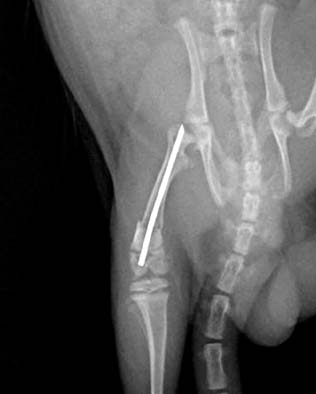J Korean Fract Soc.
2009 Jan;22(1):45-50. 10.12671/jkfs.2009.22.1.45.
The Effect of COX-2 Inhibitor on the Expression of MMP-13 during Early Fracture Healing Phase in Rats
- Affiliations
-
- 1Department of Orthopaedic Surgery, Yong-San Hospital, Chung-Ang University College of Medicine, Seoul, Korea. gustinolhj@hanafos.com
- KMID: 2183887
- DOI: http://doi.org/10.12671/jkfs.2009.22.1.45
Abstract
- PURPOSE
This study investigated the effect of COX-2 inhibitor on the expression of MMP-13 in the healing process of fracture. MATERIAL AND METHODS: Adult Sprague-Dawley rats were divided into two groups of twenty five rats each. Unilateral femoral shaft fractures were created artificially under displacement in all two groups. COX-2 inhibitor was only given to the experimental group from the postoperative day 1. At 2 weeks after fracture the rats were sacrificed and the callus from each group was used for histologic examination and real time RT-PCR for MMP-13 expression.
RESULTS
Histologically, proliferation of osteoblasts and formation of osteoid was less abundant in the experimental group. In real time RT-PCR, the mean expression of MMP-13 is 2.84+/-2.50 in the control group compared with 1.16+/-1.05 in the experimental group.
CONCLUSION
In the early stage of fracture healing, COX-2 inhibitor suppress the expression of MMP-13.
Keyword
MeSH Terms
Figure
Reference
-
1. Akritopoulos P, Papaioannidou P, Hatzokos I, et al. Parecoxib has non-significant long-term effects on bone healing in rats when administered for a short period after fracture. Arch Orthop Trauma Surg. 2009; 129:1427–1432.
Article2. Altman RD, Latta LL, Keer R, Renfree K, Hornicek FJ, Banovac K. Effect of nonsteroidal antiinflammatory drugs on fracture healing: a laboratory study in rats. J Orthop Trauma. 1995; 9:392–400.3. Bonnarens F, Einhorn TA. Production of a standard closed fracture in laboratory animal bone. J Orthop Res. 1984; 2:97–101.
Article4. Brown KM, Saunders MM, Kirsch T, Donahue HJ, Reid JS. Effect of COX-2-specific inhibition on fracture-healing in the rat femur. J Bone Joint Surg Am. 2004; 86:116–123.
Article5. Dunstan CR, Boyce R, Boyce BF, et al. Systemic administration of acidic fibroblast growth factor (FGF-1) prevents bone loss and increases new bone formation in ovariectomized rats. J Bone Miner Res. 1999; 14:953–959.
Article6. Endo K, Sairyo K, Komatsubara S, et al. Cyclooxygenase-2 inhibitor inhibits the fracture healing. J Physiol Anthropol Appl Human Sci. 2002; 21:235–238.
Article7. Freije JM, Diez-Itza I, Balbin M, et al. Molecular cloning and expression of collagenase-3, a novel human matrix metalloproteinase produced by breast carcinomas. J Biol Chem. 1994; 269:16766–16773.
Article8. Gack S, Vallon R, Schmidt J, et al. Expression of interstitial collagenase during skeletal development of the mouse is restricted to osteoblast-like cells and hypertrophic chondrocytes. Cell Growth Differ. 1995; 6:759–767.9. Gerstenfeld LC, Thiede M, Seibert K, et al. Differential inhibition of fracture healing by non-selective and cyclooxygenase-2 selective non-steroidal anti-inflammatory drugs. J Orthop Res. 2003; 21:670–675.
Article10. Henriet P, Rousseau GG, Eeckhout Y. Cloning and sequencing of mouse collagenase cDNA. Divergence of mouse and rat collagenases from the other mammalian collagenases. FEBS Lett. 1992; 310:175–178.
Article11. Holliday LS, Welgus HG, Fliszar CJ, Veith GM, Jeffrey JJ, Gluck SL. Initiation of osteoclast bone resorption by interstitial collagenase. J Biol Chem. 1997; 272:22053–22058.
Article12. Kherif S, Lafuma C, Dehaupas M, et al. Expression of matrix metalloproteinases 2 and 9 in regenerating skeletal muscle: a study in experimentally injured and mdx muscles. Dev Biol. 1999; 205:158–170.
Article13. Knäuper V, López-Otin C, Smith B, Knight G, Murphy G. Biochemical characterization of human collagenase-3. J Biol Chem. 1996; 271:1544–1550.
Article14. Lee SH, Soyoola E, Chanmugam P, et al. Selective expression of mitogen-inducible cyclooxygenase in macrophages stimulated with lipopolysaccharide. J Biol Chem. 1992; 267:25934–25938.
Article15. Sato H, Takino T, Okada Y, et al. A matrix metalloproteinase expressed on the surface of invasive tumour cells. Nature. 1994; 370:61–65.
Article16. Schwartz JI, Chan CC, Mukhopadhyay S, et al. Cyclooxygenase-2 inhibition by rofecoxib reverses naturally occurring fever in humans. Clin Pharmacol Ther. 1999; 65:653–660.
Article17. Seibert K, Masferrer JL. Role of inducible cyclooxygenase (COX-2) in inflammation. Receptor. 1994; 4:17–23.18. Simon AM, Manigrasso MB, O'Connor JP. Cyclo-oxygenase 2 function is essential for bone fracture healing. J Bone Miner Res. 2002; 17:963–976.
Article19. Ståhle-Bäckdahl M, Sandstedt B, Bruce K, et al. Collagenase-3 (MMP-13) is expressed during human fetal ossification and re-expressed in postnatal bone remodeling and in rheumatoid arthritis. Lab Invest. 1997; 76:717–728.20. Uusitalo H, Hiltunen A, Soderstrom M, Aro HT, Vuorio E. Expression of cathepsins B, H, K, L, and S and matrix metalloproteinases 9 and 13 during chondrocyte hypertrophy and endochondral ossification in mouse fracture callus. Calcif Tissue Int. 2000; 67:382–390.
Article21. Vincenti MP, Brinckerhoff CE. The potential of signal transduction inhibitors for the treatment of arthritis: Is it all just JNK? J Clin Invest. 2001; 108:181–183.
Article
- Full Text Links
- Actions
-
Cited
- CITED
-
- Close
- Share
- Similar articles
-
- The Effect of Hyaluronic Acid on the Expression of MMP-13 in Healing Process of Bone Defect in Rats
- Matrix Metalloproteinase-1 and Transforming Growth Factor-beta1 Expression during Distraction Osteogenesis and Fracture Healing of the Rat
- Basic Study on the Effect of Korean Ginseng upon Fracture Healing of the Bone
- Role of Cyclooxygense-2 in Lipopolysacharide induced Matrix Metalloproteinase-2 and -9 expressions in human trophoblast (TL) cell line
- The Effect of Platelet-rich Plasma on Wounds of OLETF Rats Using Expression of Matrix Metalloproteinase-2 and -9 mRNA



